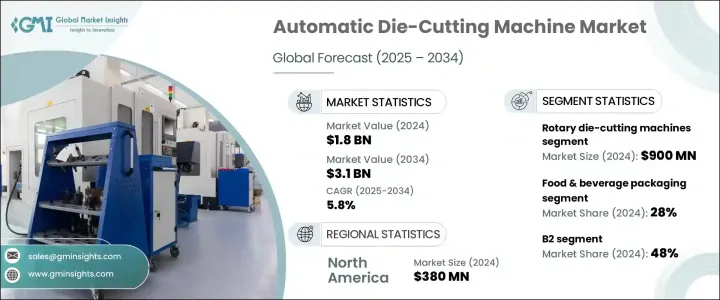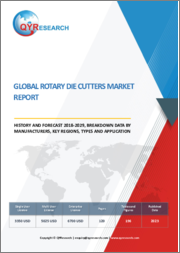
|
시장보고서
상품코드
1708218
자동 다이 커팅 머신 시장 기회, 성장 촉진요인, 산업 동향 분석, 예측(2025-2034년)Automatic Die-Cutting Machine Market Opportunity, Growth Drivers, Industry Trend Analysis, and Forecast 2025 - 2034 |
||||||
세계의 자동 다이 커팅 머신 시장은 2024년에 18억 달러를 창출하며, 2025-2034년에 CAGR 5.8%로 성장할 것으로 예측됩니다.
이러한 성장의 원동력은 E-Commerce의 확대, 빠르게 움직이는 소비재(FMCG) 수요 증가, 식품 및 음료 산업의 급격한 증가에 기인합니다. 이러한 산업이 계속 발전함에 따라 첨단 정밀하고 효율적인 포장 솔루션에 대한 요구는 자동 다이 커팅 머신에 대한 수요를 촉진하고 있습니다. 이 분야의 기업은 생산성 향상, 오류 감소, 전반적인 운영 효율성 강화를 위해 이러한 기계를 점점 더 많이 채택하고 있습니다. 또한 심미적으로 매력적이고 맞춤 디자인된 포장에 대한 소비자의 선호도가 높아지면서 시장 성장에 기여하고 있습니다. 지속가능한 포장에 대한 인식이 높아짐에 따라 많은 제조업체들이 규제 기준과 소비자의 기대에 부응하기 위해 친환경 소재와 기술을 다이 커팅 공정에 적용하고 있습니다. 자동화와 디지털 기술의 도입은 포장에 더욱 큰 변화를 가져왔으며, 기업은 높은 품질과 안전 기준을 유지하면서 생산 공정을 간소화할 수 있게 되었습니다. 이러한 첨단 포장으로 인해 자동 다이 커팅 머신은 현대 포장 환경에서 필수적인 자산이 되었습니다.

기술 혁신은 시장 성장에 중요한 역할을 하고 있습니다. 사물인터넷(IoT), 로봇 공학 및 레이저 다이 커팅 기술의 통합으로 이러한 기계의 속도, 정확성 및 유연성이 향상되고 있으며, IoT 지원 시스템은 실시간 모니터링 및 예측 유지보수를 가능하게 하여 다운타임을 최소화하고 원활한 생산 공정을 보장합니다. 정밀도와 범용성으로 유명한 레이저 다이 커팅 기술은 점점 더 복잡한 디자인 및 맞춤형 형상을 제조하는 데 사용되고 있습니다. 로봇 공학은 자재 취급 및 마무리 공정을 더욱 자동화하여 사람의 개입을 최소화하고 원활한 생산을 가능하게 합니다. 이러한 기술 발전으로 인해 자동 다이 커팅 머신은 사업을 확장하고 경쟁력을 유지하고자 하는 제조업체에게 더욱 매력적으로 다가오고 있습니다.
| 시장 범위 | |
|---|---|
| 시작연도 | 2024년 |
| 예측연도 | 2025-2034년 |
| 시작 금액 | 18억 달러 |
| 예상 금액 | 31억 달러 |
| CAGR | 5.8% |
로터리 다이 커팅 머신 분야는 2024년 9억 달러 규모에 달하며, 2034년까지 연평균 6.5%의 성장률을 보일 것으로 예측됩니다. 이 기계는 효율이 높고 원통형 금형을 사용하여 연속적으로 생산할 수 있으므로 대량 생산 현장에서 점점 더 선호되고 있습니다. 포장 산업에서 널리 사용되는 로터리 다이 커팅 머신은 라벨, 골판지 상자 및 기타 맞춤형 디자인 제품과 같은 정밀 제품 생산에 탁월합니다. 고속으로 일관성과 정밀도를 유지할 수 있으므로 대규모 제조 작업의 요구 사항을 충족시키는 데 이상적입니다.
자동 다이 커팅 머신 시장은 화장품, 의약품, 가전제품, 식품 포장 등 다양한 산업에 적용되고 있으며, 2024년에는 식품 및 음료 분야가 28% 시장 점유율을 차지할 것으로 예상되는데, 이는 맞춤형 포장 형태와 디자인에 대한 수요가 증가하고 있기 때문입니다. 자동 다이 커팅 머신은 식품 산업의 엄격한 위생 및 안전 기준을 충족하는 정확한 카톤, 라벨 및 연포장을 생산하는 데 필수적입니다. 이 기계는 식품 등급의 재료를 처리할 수 있도록 설계되었으며, 식품 안전성이 높은 잉크 및 코팅이 장착되어 있으며, 업계 규정을 준수할 수 있도록 보장합니다.
북미 자동 다이 커팅 머신 시장은 78%의 압도적인 점유율을 차지하며 2024년 3억 8,000만 달러 규모 시장을 형성했습니다. 이 지역의 성장 원동력은 지속적인 기술 발전, 첨단 포장 솔루션에 대한 수요 증가, 식품 및 음료 부문의 성장에 기인합니다. 북미에는 자동 장비 셋업, 디지털 다이 커팅 시스템 등 첨단 솔루션 개발에 주력하는 주요 제조업체와 기술 프로바이더가 다수 존재합니다. 이러한 기술 혁신은 북미를 자동 다이 커팅 머신 산업에서 기술 발전의 거점으로 자리매김하고 있으며, 세계 시장에서 이 지역의 리더십에 기여하고 있습니다.
목차
제1장 조사 방법과 조사 범위
제2장 개요
제3장 업계 인사이트
- 에코시스템 분석
- 밸류체인에 영향을 미치는 요인
- 이익률 분석
- 파괴
- 향후 전망
- 제조업체
- 유통업체
- 공급업체 상황
- 주요 뉴스와 구상
- 기술적 전망
- 규제 상황
- 영향요인
- 촉진요인
- 포장 업계의 성장
- 지속가능한 친환경 포장재료에 대한 주목의 증가
- 업계의 잠재적 리스크 & 과제
- 높은 초기 투자와 정비 비용
- 숙련 노동자의 부족
- 촉진요인
- 성장 가능성 분석
- Porter의 산업 분석
- PESTEL 분석
제4장 경쟁 구도
- 서론
- 기업 점유율 분석
- 경쟁 포지셔닝 매트릭스
- 전략 전망 매트릭스
제5장 시장 추산·예측 : 기계 유형별, 2021-2034년
- 주요 동향
- 로터리 다이 커팅 머신
- 플랫베드형 다이 커팅 머신
- 디지털 다이 커팅 머신
- 레이저 다이 커팅 머신
제6장 시장 추산·예측 : 포맷 클래스별, 2021-2034년
- 주요 동향
- B2
- B1
- B0
제7장 시장 추산·예측 : 최종 용도별, 2021-2034년
- 주요 동향
- 골판지
- 솔리드 보드(경질 보드)
- 기타(칩 보드, 허니콤 보드, 레이어 패드 등)
제8장 시장 추산·예측 : 용도별, 2021-2034년
- 주요 동향
- 화장품·퍼스널케어
- 식품 및 음료 포장
- 의약품
- 가전·내구소비재
- 인쇄·출판
- 기타
제9장 시장 추산·예측 : 유통 채널별, 2021-2034년
- 주요 동향
- 직접 판매
- 간접 판매
제10장 시장 추산·예측 : 지역별, 2021-2034년
- 주요 동향
- 북미
- 미국
- 캐나다
- 유럽
- 영국
- 독일
- 프랑스
- 이탈리아
- 스페인
- 러시아
- 아시아태평양
- 중국
- 인도
- 일본
- 한국
- 호주
- 라틴아메리카
- 브라질
- 멕시코
- 중동 및 아프리카
- UAE
- 사우디아라비아
- 남아프리카공화국
제11장 기업 개요
- Asahi Machinery
- Berhalter
- Biermann
- Bobst
- Duplo
- Heidelberger Druckmaschinen
- Kama
- Koenig &Bauer
- Komori
- Masterwork(MK) Machinery
- MPS Systems
- Sanwa
- ThermoFlexX(Xeikon)
- Winkler+Dunnebier
- Yutian DGM Machinery
The Global Automatic Die-Cutting Machine Market generated USD 1.8 billion in 2024 and is projected to grow at a CAGR of 5.8% between 2025 and 2034. This growth is driven by the expansion of e-commerce, increasing demand for fast-moving consumer goods (FMCG), and a surge in the food and beverage industry. As these industries continue to evolve, the need for advanced, precise, and efficient packaging solutions is fueling the demand for automatic die-cutting machines. Companies across these sectors are increasingly adopting these machines to improve productivity, reduce errors, and enhance overall operational efficiency. Additionally, rising consumer preferences for aesthetically appealing and custom-designed packaging are contributing to the market's upward trajectory. With growing awareness about sustainable packaging, many manufacturers are integrating eco-friendly materials and technologies into their die-cutting processes to meet regulatory standards and consumer expectations. The adoption of automation and digital technologies is further transforming the packaging landscape, allowing companies to streamline production processes while maintaining high quality and safety standards. These advancements position automatic die-cutting machines as indispensable assets in modern packaging environments.

Technological innovations are playing a crucial role in boosting market growth. The integration of the Internet of Things (IoT), robotics, and laser die-cutting technology has enhanced the speed, accuracy, and flexibility of these machines. IoT-enabled systems allow real-time monitoring and predictive maintenance, minimizing downtime and ensuring smooth production processes. Laser die-cutting technology, known for its precision and versatility, is increasingly being adopted to produce intricate designs and custom shapes. Robotics has further automated the material handling and finishing processes, allowing for seamless production with minimal human intervention. These technological advancements make automatic die-cutting machines more appealing to manufacturers aiming to scale their operations and maintain a competitive edge.
| Market Scope | |
|---|---|
| Start Year | 2024 |
| Forecast Year | 2025-2034 |
| Start Value | $1.8 Billion |
| Forecast Value | $3.1 Billion |
| CAGR | 5.8% |
The rotary die-cutting machines segment generated USD 900 million in 2024 and is expected to grow at a CAGR of 6.5% through 2034. These machines are increasingly preferred in mass-production settings due to their high efficiency and ability to produce continuous output using cylindrical dies. Widely used in the packaging industry, rotary die-cutting machines excel in producing precision items such as labels, corrugated boxes, and other custom-designed products. Their ability to maintain consistency and precision at high speeds makes them ideal for meeting the demands of large-scale manufacturing operations.
In terms of application, the automatic die-cutting machine market serves a diverse range of industries, including cosmetics, pharmaceuticals, consumer electronics, and food packaging. The food and beverage sector accounted for a 28% market share in 2024, driven by the growing demand for custom packaging shapes and designs. Automatic die-cutting machines are essential in producing precise cartons, labels, and flexible packaging that meet the stringent hygiene and safety standards of the food industry. These machines are designed to handle food-grade materials and are equipped with food-safe inks and coatings, ensuring compliance with industry regulations.
North America automatic die-cutting machine market held a dominant 78% share and generated USD 380 million in 2024. The region's growth is fueled by continuous technological advancements, increasing demand for advanced packaging solutions, and the expanding food and beverage sector. North America is home to numerous major manufacturers and technology providers focused on developing cutting-edge solutions, including automated equipment setup and digital die-cutting systems. These innovations contribute to the region's leadership in the global market, positioning North America as a hub for technological progress in the automatic die-cutting machine industry.
Table of Contents
Chapter 1 Methodology & Scope
- 1.1 Market scope & definitions
- 1.2 Base estimates & calculations
- 1.3 Forecast calculations.
- 1.4 Data sources
- 1.4.1 Primary
- 1.4.2 Secondary
- 1.4.2.1 Paid sources
- 1.4.2.2 Public sources
Chapter 2 Executive Summary
- 2.1 Industry synopsis, 2021-2034
Chapter 3 Industry Insights
- 3.1 Industry ecosystem analysis
- 3.1.1 Factor affecting the value chain
- 3.1.2 Profit margin analysis
- 3.1.3 Disruptions
- 3.1.4 Future outlook
- 3.1.5 Manufactures
- 3.1.6 Distributors
- 3.2 Supplier landscape
- 3.3 Key news & initiatives
- 3.4 Technological landscape
- 3.5 Regulatory landscape
- 3.6 Impact forces
- 3.6.1 Growth drivers
- 3.6.1.1 Growth of packaging industry
- 3.6.1.2 Increasing focus on sustainable and eco-friendly packaging materials
- 3.6.2 Industry pitfalls & challenges
- 3.6.2.1 High initial investment and maintenance costs
- 3.6.2.2 Skilled labor shortage
- 3.6.1 Growth drivers
- 3.7 Growth potential analysis
- 3.8 Porter's analysis
- 3.9 PESTEL analysis
Chapter 4 Competitive Landscape, 2024
- 4.1 Introduction
- 4.2 Company market share analysis
- 4.3 Competitive positioning matrix
- 4.4 Strategic outlook matrix
Chapter 5 Market Estimates & Forecast, By Machine Type, 2021-2034 (USD Billion) (Thousand Units)
- 5.1 Key trends
- 5.2 Rotary die-cutting machines
- 5.3 Flatbed die-cutting machines
- 5.4 Digital die-cutting machines
- 5.5 Laser die-cutting machines
Chapter 6 Market Estimates & Forecast, By Format Classes, 2021-2034 (USD Billion) (Thousand Units)
- 6.1 Key trends
- 6.2 B2
- 6.3 B1
- 6.4 B0
Chapter 7 Market Estimates & Forecast, By End Use, 2021-2034 (USD Billion) (Thousand Units)
- 7.1 Key trends
- 7.2 Corrugated board
- 7.3 Solid board (rigid board)
- 7.4 Others (chipboard, honeycomb board, layer pads, etc.)
Chapter 8 Market Estimates & Forecast, By Application, 2021-2034 (USD Billion) (Thousand Units)
- 8.1 Key trends
- 8.2 Cosmetics and personal care
- 8.3 Food & beverage packaging
- 8.4 Pharmaceuticals
- 8.5 Consumer electronics and durable goods
- 8.6 Printing and publishing
- 8.7 Others
Chapter 9 Market Estimates & Forecast, By Distribution Channel, 2021-2034 (USD Billion) (Thousand Units)
- 9.1 Key trends
- 9.2 Direct sales
- 9.3 Indirect sales
Chapter 10 Market Estimates & Forecast, By Region, 2021-2034 (USD Billion) (Thousand Units)
- 10.1 Key trends
- 10.2 North America
- 10.2.1 U.S.
- 10.2.2 Canada
- 10.3 Europe
- 10.3.1 UK
- 10.3.2 Germany
- 10.3.3 France
- 10.3.4 Italy
- 10.3.5 Spain
- 10.3.6 Russia
- 10.4 Asia Pacific
- 10.4.1 China
- 10.4.2 India
- 10.4.3 Japan
- 10.4.4 South Korea
- 10.4.5 Australia
- 10.5 Latin America
- 10.5.1 Brazil
- 10.5.2 Mexico
- 10.6 MEA
- 10.6.1 UAE
- 10.6.2 Saudi Arabia
- 10.6.3 South Africa
Chapter 11 Company Profiles
- 11.1 Asahi Machinery
- 11.2 Berhalter
- 11.3 Biermann
- 11.4 Bobst
- 11.5 Duplo
- 11.6 Heidelberger Druckmaschinen
- 11.7 Kama
- 11.8 Koenig & Bauer
- 11.9 Komori
- 11.10 Masterwork (MK) Machinery
- 11.11 MPS Systems
- 11.12 Sanwa
- 11.13 ThermoFlexX (Xeikon)
- 11.14 Winkler+Dunnebier
- 11.15 Yutian DGM Machinery















